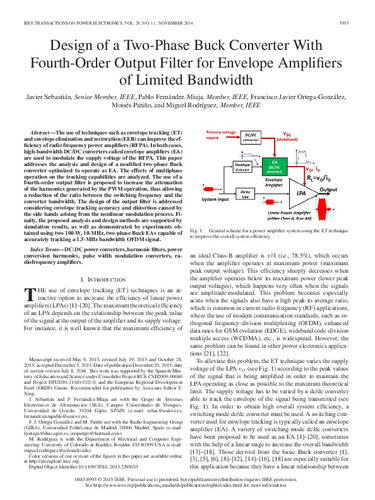Design of a two-phase buck converter with fourth-order output filter for envelope amplifiers of limited bandwidt
Fecha de publicación:
Editorial:
IEEE
Versión del editor:
Citación:
Descripción física:
Resumen:
The use of techniques such as envelope tracking (ET) and envelope elimination and restoration (EER) can improve the efficiency of radio frequency power amplifiers (RFPA). In both cases, high-bandwidth DC/DC converters called envelope amplifiers (EA) are used to modulate the supply voltage of the RFPA. This paper addresses the analysis and design of a modified two-phase Buck converter optimized to operate as EA. The effects of multiphase operation on the tracking capabilities are analyzed. The use of a fourth-order output filter is proposed to increase the attenuation of the harmonics generated by the PWM operation, thus allowing a reduction of the ratio between the switching frequency and the converter bandwidth. The design of the output filter is addressed considering envelope tracking accuracy and distortion caused by the side bands arising from the nonlinear modulation process. Finally, the proposed analysis and design methods are supported by simulation results, as well as demonstrated by experiments obtained using two 100-W, 10-MHz, two-phase Buck EAs capable of accurately tracking a 1.5-MHz bandwidth OFDM signal
The use of techniques such as envelope tracking (ET) and envelope elimination and restoration (EER) can improve the efficiency of radio frequency power amplifiers (RFPA). In both cases, high-bandwidth DC/DC converters called envelope amplifiers (EA) are used to modulate the supply voltage of the RFPA. This paper addresses the analysis and design of a modified two-phase Buck converter optimized to operate as EA. The effects of multiphase operation on the tracking capabilities are analyzed. The use of a fourth-order output filter is proposed to increase the attenuation of the harmonics generated by the PWM operation, thus allowing a reduction of the ratio between the switching frequency and the converter bandwidth. The design of the output filter is addressed considering envelope tracking accuracy and distortion caused by the side bands arising from the nonlinear modulation process. Finally, the proposed analysis and design methods are supported by simulation results, as well as demonstrated by experiments obtained using two 100-W, 10-MHz, two-phase Buck EAs capable of accurately tracking a 1.5-MHz bandwidth OFDM signal
Patrocinado por:
Spanish Ministry of Education and Science under Consolider Project [RUE CSD2009-00046, DPI2010-21110-C02-0]; European Regional Development Fund (ERDF) Grants
Colecciones
Ficheros en el ítem




